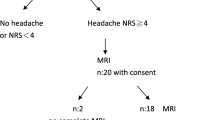Abstract
Pregnant women developing generalised tonic–clonic seizures in the absence of a prior neurological disorder are often diagnosed as eclamptic. Posterior reversible encephalopathy syndrome (PRES) is a distinct neuroimaging condition associated with long-term sequelae, which may occur in pregnancy. Some reports suggested PRES to be the pathophysiological process leading to eclampsia, whereas others observed PRES and eclampsia to have varying clinical severity and risk factors. In this case–control study, risk factors associated with PRES were compared to those for eclampsia in women with hypertension presenting with seizures who had undergone neuroimaging. PRES was noted to occur in 22.5% (51/227) hypertensive pregnant women presenting with seizures that otherwise would have been classified as eclampsia. An additional 51 women with eclampsia underwent neuroimaging. Women who had PRES had higher systolic (155.3 vs 144.5, p = 0.04), diastolic (99.2 vs 93.4, p = 0.006) and mean (117.9 vs 110.4, p = 0.001) blood pressure at admission compared to those with eclampsia. Eclampsia and PRES may occur through a similar pathophysiological mechanism, resulting in the same spectrum of neurological complications of preeclampsia, with PRES being the severest form of the disease process. PRES is difficult to differentiate from eclampsia based on clinical and laboratory investigation, except for high blood pressures, without adjunctive MRI/CT neuroimaging. Future studies should assess the role of biomarkers as well as long-term neurological sequelae in pregnant women with a diagnosis of PRES.


Similar content being viewed by others
Data availability
The data underlying this article will be shared on reasonable request to the corresponding author.
References
Fishel Bartal M, Sibai BM (2020) Eclampsia in the 21st century. Am J Obstet Gynecol S0002-9378(20)31128–31135
Fugate JE, Rabinstein AA (2015) Posterior reversible encephalopathy syndrome: clinical and radiological manifestations, pathophysiology, and outstanding questions. Lancet Neurol 14(9):914–925
Garg RK, Kumar N, Malhotra HS (2018) Posterior reversible encephalopathy syndrome in eclampsia. Neurol India 66(5):1316–1323
Saad AF, Chaudhari R, Wintermark M (2019) Imaging of atypical and complicated posterior reversible encephalopathy syndrome. Front Neurol 10:964
Postma IR, Slager S, Kremer HP, de Groot JC, Zeeman GG (2014) Long-term consequences of the posterior reversible encephalopathy syndrome in eclampsia and preeclampsia: a review of the obstetric and nonobstetric literature. Obstet Gynecol Surv 69(5):287–300
Verma AK, Garg RK, Pradeep Y, Malhotra HS, Rizvi I, Kumar N, Kohli N, Pandey S (2017) Posterior encephalopathy syndrome in women with eclampsia: predictors and outcome. Pregnancy Hypertens 10:74–82
Mayama M, Uno K, Tano S, Yoshihara M, Ukai M, Kishigami Y, Ito Y, Oguchi H (2016) Incidence of posterior reversible encephalopathy syndrome in eclamptic and patients with preeclampsia with neurologic symptoms. Am J Obstet Gynecol 215(2):239 e1–5
Fisher N, Saraf S, Egbert N, Homel P, Stein EG, Minkoff H (2016) Clinical correlates of posterior reversible encephalopathy syndrome in pregnancy. J Clin Hypertens (Greenwich) 18(6):522–527
Brewer J, Owens MY, Wallace K, Reeves AA, Morris R, Khan M, LaMarca B, Martin JN Jr (2013) Posterior reversible encephalopathy syndrome in 46 of 47 patients with eclampsia. Am J Obstet Gynecol 208(6):468 e1–6
Camara-Lemarroy CR, Escobedo-Zuniga N, Villarreal-Garza E, Garcia-Valadez E, Gongora-Rivera F, Villarreal-Velazquez HJ (2017) Posterior reversible leukoencephalopathy syndrome (PRES) associated with severe eclampsia: clinical and biochemical features. Pregnancy Hypertens 7:44–49
Wen Y, Yang B, Huang Q, Liu Y (2017) Posterior reversible encephalopathy syndrome in pregnancy: a retrospective series of 36 patients from mainland China. Ir J Med Sci 186(3):699–705
Bojja V, Keepanasseril A, Nair PP, Sunitha VC (2018) Clinical and imaging profile of patients with new-onset seizures & a presumptive diagnosis of eclampsia - a prospective observational study. Pregnancy Hypertens 12:35–39
Brown MA, Magee LA, Kenny LC, Karumanchi SA, McCarthy FP, Saito S, Hall DR, Warren CE, Adoyi G, Ishaku S, P. International Society for the Study of Hypertension in (2018) Hypertensive disorders of pregnancy: ISSHP classification, diagnosis, and management recommendations for international practice. Hypertension 72(1):24–43
Keepanasseril A, Maurya DK, Manikandan K, Suriya JY, Habeebullah S, Raghavan SS (2018) Prophylactic magnesium sulphate in prevention of eclampsia in women with severe preeclampsia: randomised controlled trial (PIPES trial). J Obstet Gynaecol 38(3):305–309
HosapatnaBasavarajappa D, Saha PK, Bagga R, Khandelwal N, Modi M (2020) Neuroradiological perspectives of severe preeclampsia and eclampsia spectrum - correlation from posterior reversible encephalopathy syndrome. Pregnancy Hypertens 20:119–123
Nick JM (2003) Deep tendon reflexes: the what, why, where, and how of tapping. J Obstet Gynecol Neonatal Nurs 32(3):297–306
Singh S, Mohakud S, Naik S, Jena SK, Sethi P, Nayak P (2021) Predictors of posterior reversible encephalopathy syndrome in women with hypertension in pregnancy: a prospective observational study. Pregnancy Hypertens 23:191–195
Pittara T, Vyrides A, Lamnisos D, Giannakou K (2021) Pre-eclampsia and long-term health outcomes for mother and infant: an umbrella review. BJOG 128(9):1421–1430
Siepmann T, Boardman H, Bilderbeck A, Griffanti L, Kenworthy Y, Zwager C, McKean D, Francis J, Neubauer S, Yu GZ, Lewandowski AJ, Sverrisdottir YB, Leeson P (2017) Long-term cerebral white and gray matter changes after preeclampsia. Neurology 88(13):1256–1264
Liman TG, Bohner G, Heuschmann PU, Scheel M, Endres M, Siebert E (2012) Clinical and radiological differences in posterior reversible encephalopathy syndrome between patients with preeclampsia-eclampsia and other predisposing diseases. Eur J Neurol 19(7):935–943
Author information
Authors and Affiliations
Corresponding author
Ethics declarations
Ethical approval
None.
Conflict of interest
None.
Additional information
Publisher's note
Springer Nature remains neutral with regard to jurisdictional claims in published maps and institutional affiliations.
Rights and permissions
About this article
Cite this article
Keepanasseril, A., Nayak, D., Bojja, V. et al. Risk factors for posterior reversible encephalopathy syndrome in hypertensive pregnant women presenting with seizures. Neurol Sci 43, 3839–3846 (2022). https://doi.org/10.1007/s10072-021-05847-2
Received:
Accepted:
Published:
Issue Date:
DOI: https://doi.org/10.1007/s10072-021-05847-2




